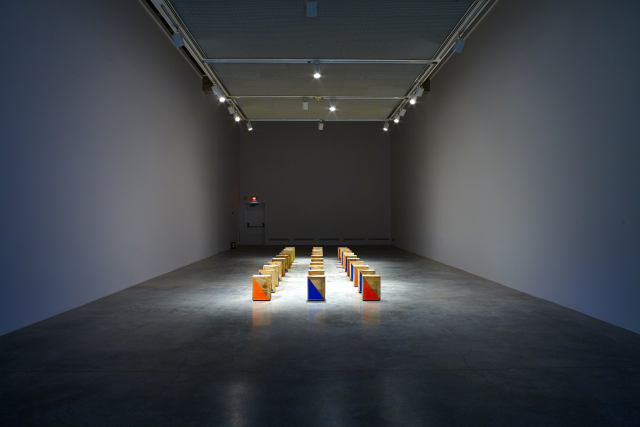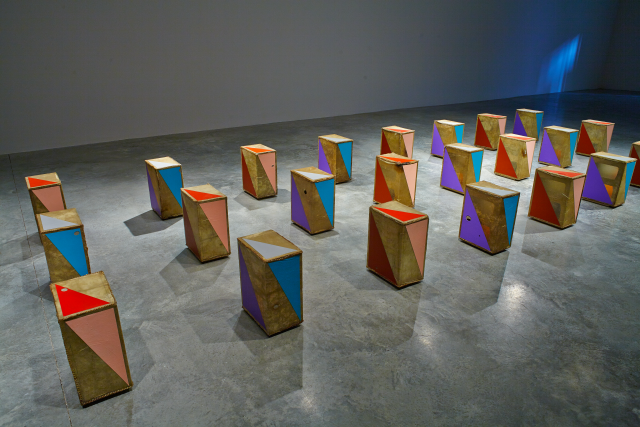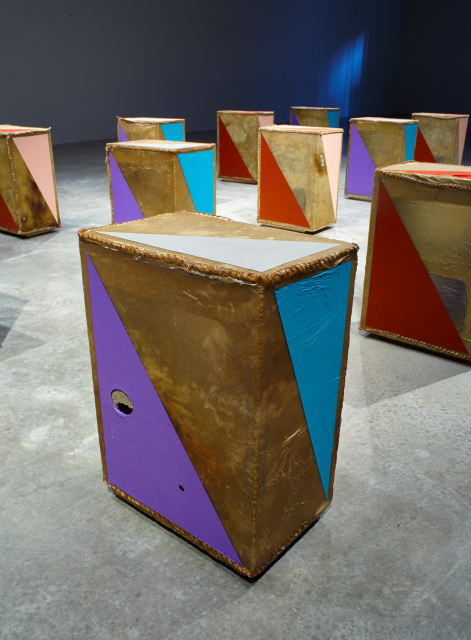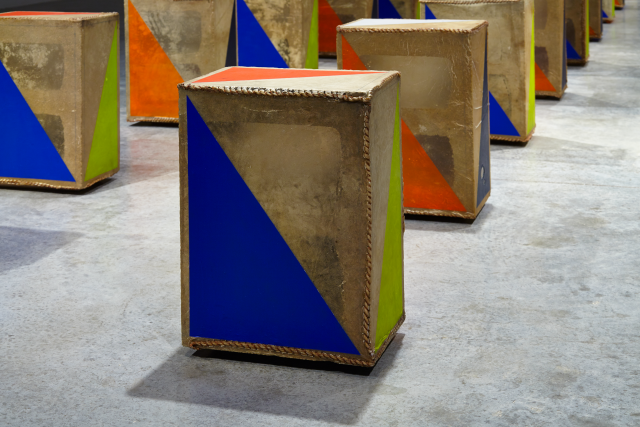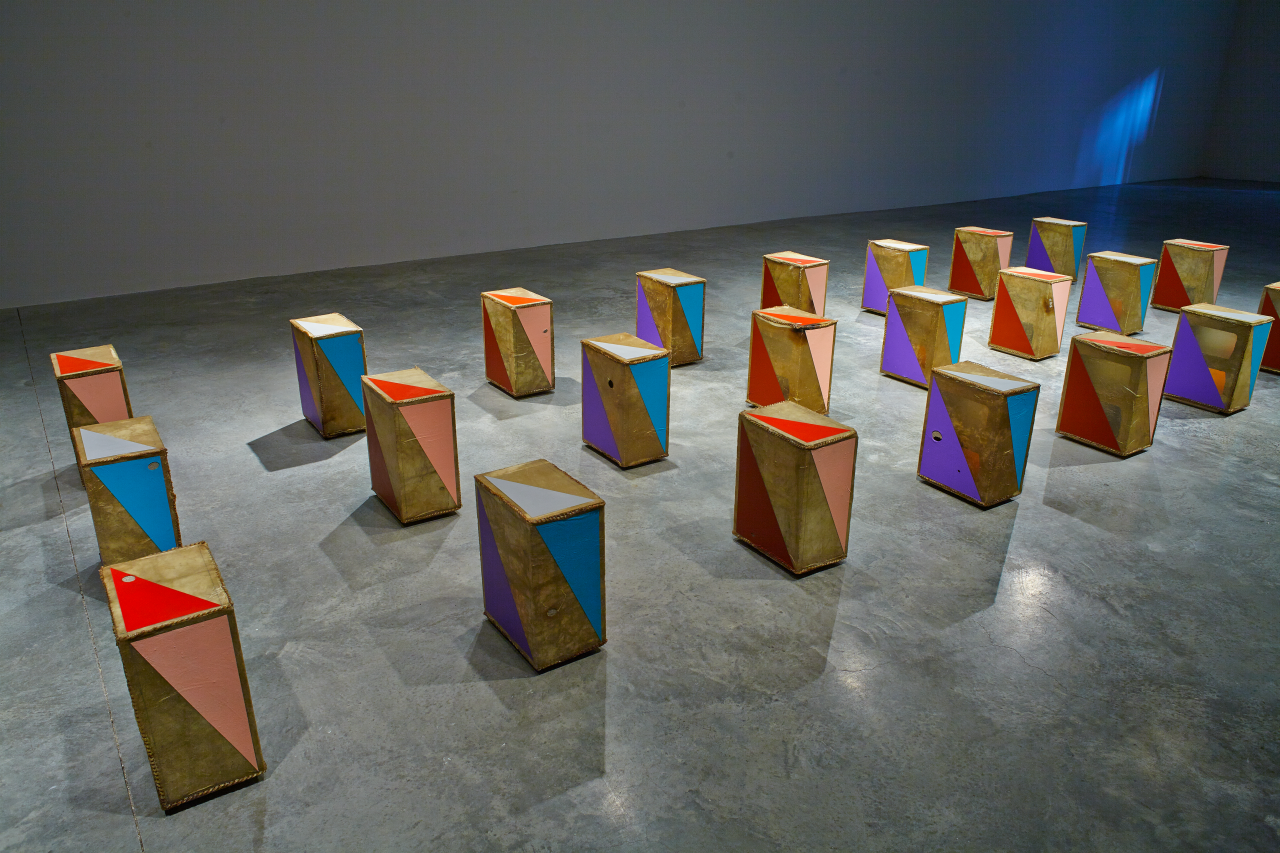
Exhibition
20 Nov 2014 - 6 Dec 2014
Illingworth Kerr GalleryCall and Response
Jeffrey Gibson: Call and Response
The IKG presents Jeffrey Gibson’s installation Call and Response. Composed of 30 cement blocks, elk rawhide, artificial sinew, coloured pencil and acrylic paint, the work evokes both minimalist sculpture as well as Aboriginal material cultures and traditions.
Gibson was artist-in-residence at the IKG in summer 2013, where he collaborated with ACAD students Emily Promise Allison, Jake Klein-Waller and Sophie-Anne Bélisle, as well as studio assistant Kirby Crone to produce a new work for the exhibition Fiction/Non-Fiction at the Esker Foundation (September 27 to December 13, 2013).
In the production process, natural elk rawhide was soaked in water and made pliable for hand stitching with artificial sinew. The rawhide was then wrapped around individual concrete cinder blocks and stitched into place. Gibson enhanced the forms by painting them with coloured triangles in red, mauve, purple, green or black. The colours chosen are not merely aesthetic, but hold deeper symbolic meanings depending on traditional tribal affiliations. The blocks are then presented in a 3 x 10 north-south grid. The mathematical rhythms of the installation recall aspects of ancient Greek art in its formal relationships and exacting proportions. As such, the work’s references waiver from the transcultural to ancient Greek and Roman to the traditional but idiosyncratic Aboriginal marker, while also representing other concerns of the artist.
The gallery installation of the 30 finished ‘markers’ is precise, ordered and clean but reading Call and Response is anything but simple. The installation resembles a sophisticated homage to both the traditional Amerindian and modernist application and manipulation of geometric forms. While Gibson may be calling attention to the Aboriginal belief in cultural continuity to dissolve past and present, it is not art world mimicry or questions of authenticity that concern him. If anything it is a heightened concern for how Aboriginal “primitive spirit” geometric grid patterns were appropriated by post-WWII artists associated with abstraction (Marsden Hartley, Arthur Dove, Josef and Anni Albers, Barnett Newman, etc.) that Gibson believes has already been acknowledged, challenged and neutralized. The hybridity of new values, ideas and materials applied to his art is the result of the artist’s own historical exchange on aesthetics and visual languages. In a recent New York Times article Gibson clarifies his intentions by drawing attention to the hybrid nature of his work. Not only is he embracing his Choctaw-Cherokee heritage but he continues to establish a new, empowering lens of hybridity to recognize “both the problematic legacies of his own heritage and the problematic legacy of modernism through the lens of geometric abstraction.” Gibson has created an unsparing vocabulary of abstraction that in turn has produced a hybrid art form. Call and Response is something more than painting and more than sculpture that reverberates with echoes of the archaic meaning of art, while the more problematic aspects of troubled and overlapping North American histories refuse to be separated from the discussion of making.
Call and Response is presented in conjunction with Stronger Than Stone: (Re)Inventing the Indigenous Monument, an international symposium on monuments and counter-monuments from Indigenous perspectives held in Calgary and Saskatoon from November 21 to 24, 2014. www.strongerthanstone.org.
Jeffrey Gibson
Jeffrey Gibson is a painter and sculptor, and also makes videos that merge elements of past Western and American art movements with more traditional materials and forms found in historic and contemporary Native American cultures. Gibson is a member of the Mississippi Band of Choctaw Indians, is half Cherokee, and has moved frequently throughout his lifetime, living in the United States, Korea, Germany, the United Kingdom and France. His work has been shown nationally and internationally at venues including the National Academy Museum, the Museum of Art and Design, and Participant INC, New York; the Museum of Fine Arts and the ICA, Boston; the Denver Art Museum; the Nerman Museum, Kansas; the Philbrook Museum, Tulsa; the National Gallery of Canada, Ottawa; and Plug-In ICA, Winnipeg among others. Gibson lives and works in Hudson, New York.
The IKG would like to acknowledge the important support of the Canada Council for the Arts, Alberta Foundation for the Arts, the Alberta College of Art + Design, CADA and an anonymous donor.
For more information on the exhibition and the IKG please contact:
Wayne Baerwaldt, Director/Curator, Exhibitions
wayne.baerwaldt@acad.ca
Alexandra McIntosh, Assistant Curator, Illingworth Kerr Gallery alexandra.mcintosh@acad.ca
Image credit: Jeffrey Gibson, Call and Response (2013). Installation view. Thirty cement blocks, elk rawhide, artificial sinew, coloured pencil and acrylic paint. Photo courtesy the artist, Marc Straus (New York), Samson (Boston), and Illingworth Kerr Gallery (Calgary).
